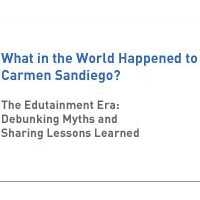 In the late ‘80s and early ‘90s, some of the best-selling video games included familiar titles such as Where in the World is Carmen Sandiego? and Oregon Trail—products that not only set the standard for video games as educational tools and but also launched an entire industry of consumer products intended to both educate and entertain. Through the success of these titles and numerous others, the “edutainment” industry blossomed and many visionary leaders and reputable companies were innovating in this realm. The design, development and distribution of children’s games intended to both educate and entertain was a blossoming industry, and one that held much excitement and promise both in terms of it’s educational potential and market opportunities.
In the late ‘80s and early ‘90s, some of the best-selling video games included familiar titles such as Where in the World is Carmen Sandiego? and Oregon Trail—products that not only set the standard for video games as educational tools and but also launched an entire industry of consumer products intended to both educate and entertain. Through the success of these titles and numerous others, the “edutainment” industry blossomed and many visionary leaders and reputable companies were innovating in this realm. The design, development and distribution of children’s games intended to both educate and entertain was a blossoming industry, and one that held much excitement and promise both in terms of it’s educational potential and market opportunities.
However, in the late ’90s, a number of factors led to an industry downturn. Within about five years, edutainment went from a burgeoning market to somewhat of a dirty word among gaming communities—a downward spiral that has had longstanding repercussions that still resonate strongly in the current market for video games.
Publishers today tend to stay away from the word “educational” in the consumer video game space. In fact, one would be hard pressed to find a recent mainstream success story of a big-budget video game in the consumer space that was designed, developed and marketed as educational. There are many popular games that have substantial educational value—Little Big Planet, The Sims, and Minecraft to name a few. However, none of these games have been intentionally designed, developed and marketed as educational.
Our research has indicated that developers and others in the consumer video games industry often attribute the edutainment industry downfall either to lack of market demand or a near impossibility in creating great products that both educate and entertain. In reality, neither of these assertions is correct; rather it was massive industry consolidation combined with other key contextual forces that led to the industry demise.
This short case study considers the edutainment era of children’s educational software and reflects on how the past can inform our current efforts to mobilize games for learning. Focusing on the consumer market as opposed to the institutional space, the report attempts to debunk some of the misconceptions around what happened to edutainment in the ‘90s, while simultaneously sharing valuable lessons learned from one of the most important periods in the history of games and learning.
Download the case study: “What in the World Happened to Carmen Sandiego? The Edutainment Era: Debunking Myths and Sharing Lessons Learned“

